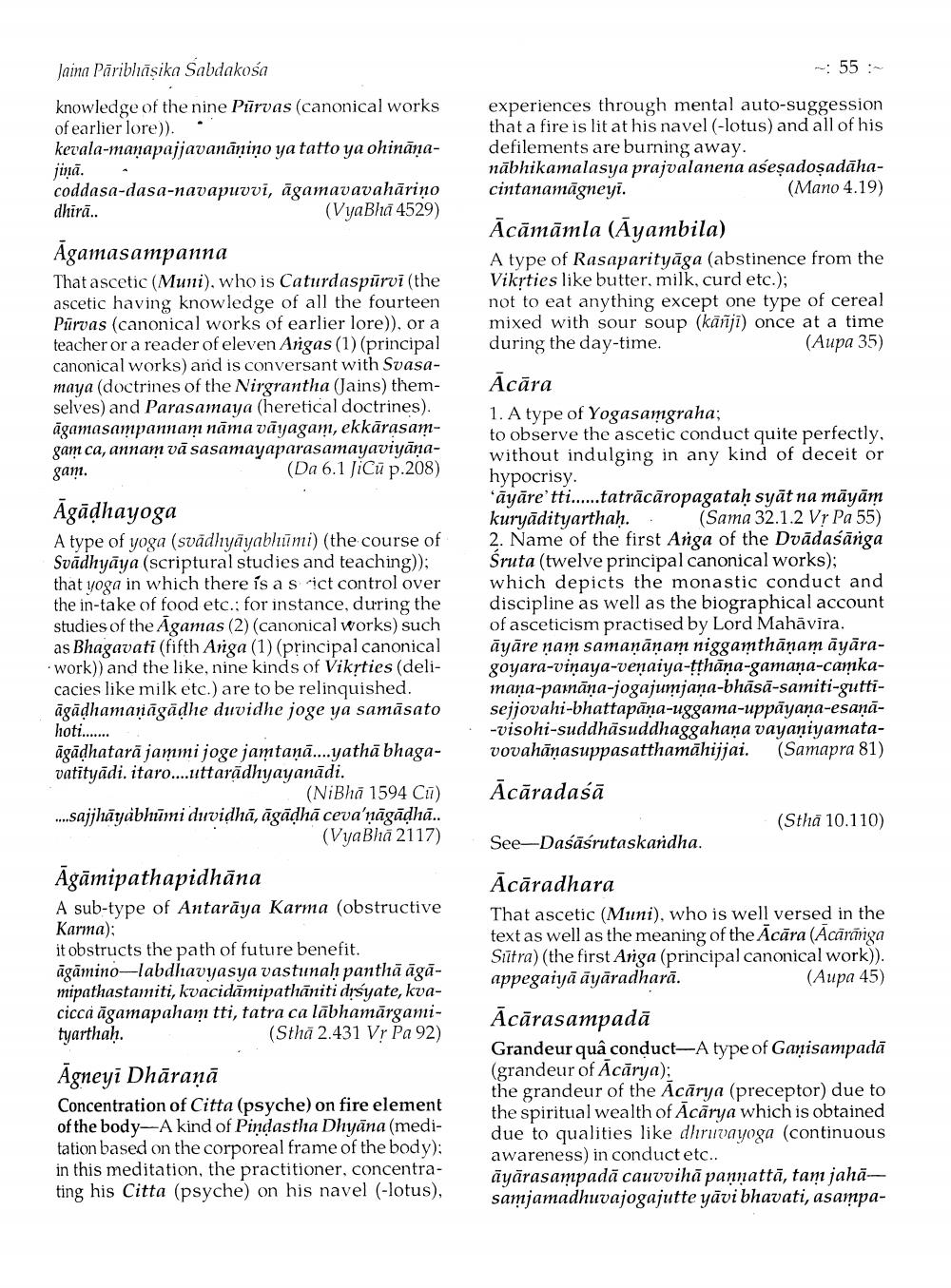________________
- 55
Jaina Pāribliāșika Sabdakosa knowledge of the nine Purvas (canonical works of earlier lore)).. kevala-manapajjavanāniņo ya tatto ya ohināņajinā. . coddasa-dasa-navapuvvi, āgamavavahāriņo dhirā..
(VyaBhā 4529)
experiences through mental auto-suggession that a fire is lit at his navel (-lotus) and all of his defilements are burning away. nābhikamalasya prajvalanena aśesadosadāhacintanamāgneyi.
(Mano 4.19)
Ācāmāmla (Ayambila) A type of Rasaparityāga (abstinence from the Vikyties like butter, milk, curd etc.); not to eat anything except one type of cereal mixed with sour soup (kārīji) once at a time during the day-time.
(Aupa 35)
Agamasampanna That ascetic (Muni), who is Caturdaspūrvi (the ascetic having knowledge of all the fourteen Purvas (canonical works of earlier lore)), or a teacher or a reader of eleven Arigas (1) (principal canonical works) and is conversant with Svasamaya (doctrines of the Nirgrantha (Jains) themselves) and Parasamaya (heretical doctrines). āgamasampannam nāma vāyagam, ekkārasamgam ca, annam vā sasamayaparasamayaviyāņagam.
(Da 6.1 JiCup.208)
Āgādhayoga A type of yoga (svādliyāyabhūmi) (the course of Svādhyāya (scriptural studies and teaching)); that yoga in which there is a s ict control over the in-take of food etc., for instance, during the studies of the Āgamas (2) (canonical works) such as Bhagavati (fifth Arga (1) (principal canonical work)) and the like, nine kinds of Vikrties (delicacies like milk etc.) are to be relinquished. āgādhamanāgādhe duvidhe joge ya samāsato
Ācāra 1. A type of Yogasamgraha; to observe the ascetic conduct quite perfectly, without indulging in any kind of deceit or hypocrisy. 'āyāre'tti......tatrācāropagataḥ syāt na māyām kuryādityarthah. (Sama 32.1.2 Vr Pa 55) 2. Name of the first Arga of the Dvādaśārga Sruta (twelve principal canonical works); which depicts the monastic conduct and discipline as well as the biographical account of asceticism practised by Lord Mahāvira. āyāre nam samaņāņam niggamthāņam āyāragoyara-viņaya-venaiya-tthāņa-gamaņa-camkamaņa-pamāna-jogajumjana-bhāsā-samiti-guttisejjovahi-bhattapāņa-uggama-uppāyaṇa-esaņā-visohi-suddhāsuddhaggahana vayaniyamatavovahānasuppasatthamāhijjai. (Samapra 81)
hoti.......
āgādhatarā jammi joge jamtaņā....yathā bhagavatityādi. itaro....uttarādhyayanādi.
(NiBhā 1594 Cu) ...sajjhāyabhumi duvidhā, āgādhā ceva'ņāgādhā..
(VyaBhā 2117)
Ācāradasā
(Sthā 10.110)
See- Dasāšrutaskandha.
Ācāradhara That ascetic (Muni), who is well versed in the text as well as the meaning of the Ācāra (Acararga Siitra) (the first Ariga (principal canonical work)). appegaiyā āyāradharā.
(Aupa 45)
Āgāmipathapidhāna A sub-type of Antarāya Karma (obstructive Karma); it obstructs the path of future benefit. āgāmino-labdhavyasya vastunah panthā āgāmipathastamiti, kvacidāmipathāniti disyate, kvacicca āgamapaham tti, tatra ca lābhamārgamityarthah.
(Sthā 2.431 Vr Pa 92) Āgneyi Dhāraņā Concentration of Citta (psyche) on fire element of the body- A kind of Pindastha Dhyana (meditation based on the corporeal frame of the body); in this meditation, the practitioner, concentrating his Citta (psyche) on his navel (-lotus),
Acārasampadā Grandeur quâ conduct- A type of Gaņisampadā (grandeur of Acārya); the grandeur of the Acārya (preceptor) due to the spiritual wealth of Ācārya which is obtained due to qualities like dhruvayoga (continuous awareness) in conduct etc.. āyārasampadā cauvvihā pannattā, tam jahasamjamadhuvajogajutte yāvibhavati, asampa




